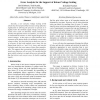Free Online Productivity Tools
i2Speak
i2Symbol
i2OCR
iTex2Img
iWeb2Print
iWeb2Shot
i2Type
iPdf2Split
iPdf2Merge
i2Bopomofo
i2Arabic
i2Style
i2Image
i2PDF
iLatex2Rtf
Sci2ools
101
Voted
ISQED
2005
IEEE
2005
IEEE
Error Analysis for the Support of Robust Voltage Scaling
Recently, a new Dynamic Voltage Scaling (DVS) scheme has been proposed that increases energy efficiency significantly by allowing the processor to operate at or slightly below the minimum supply voltage even if occasional errors result. To determine which technique can reliably and efficiently detect such failures, it is necessary to understand the manner in which digital designs fail at critical voltages. In this paper, we report hardware measurements of the failure modes of a multiplier circuit under voltage scaling. We show that even at small error rates, it is necessary to deal with multiple errors where bits are flipped from both 0 to 1 and 1 to 0. Intra- and inter-die variations make the exact nature of these flips unpredictable. This suggests that conventional single and unidirectional error detectors will not work. We conclude that the most suitable solution is a simple delay-error tolerant flipflop that detects and corrects errors by double sampling signals.
Related Content
| Added | 25 Jun 2010 |
| Updated | 25 Jun 2010 |
| Type | Conference |
| Year | 2005 |
| Where | ISQED |
| Authors | David Roberts, Todd M. Austin, David Blaauw, Trevor N. Mudge, Krisztián Flautner |
Comments (0)

